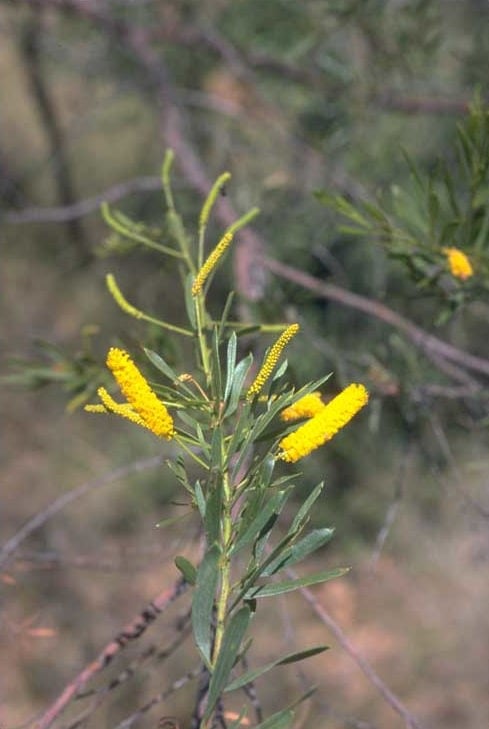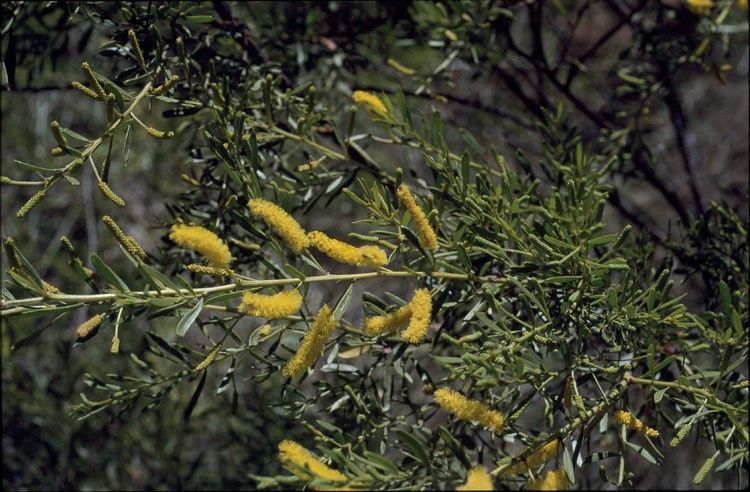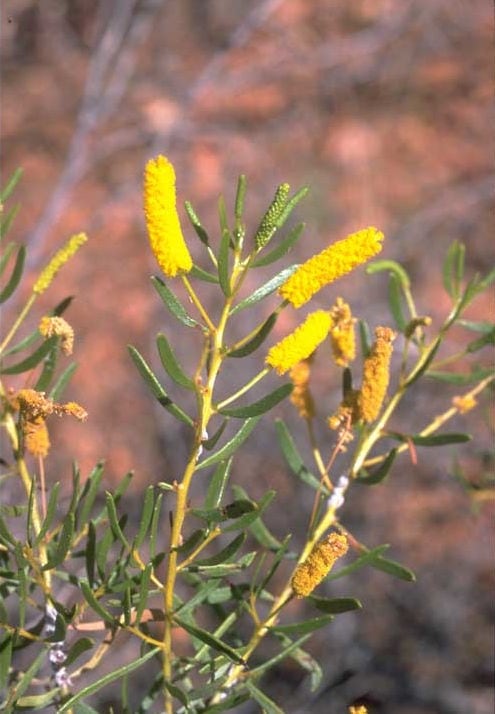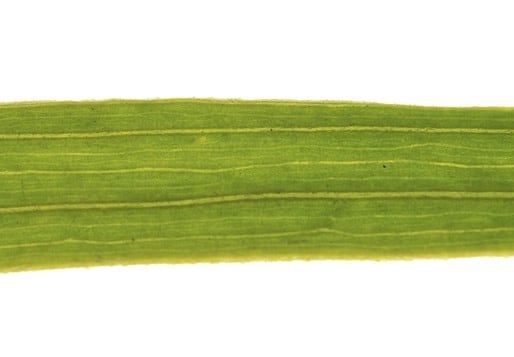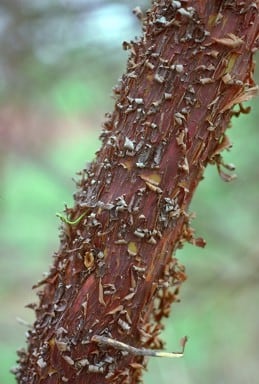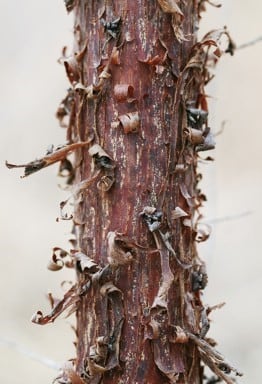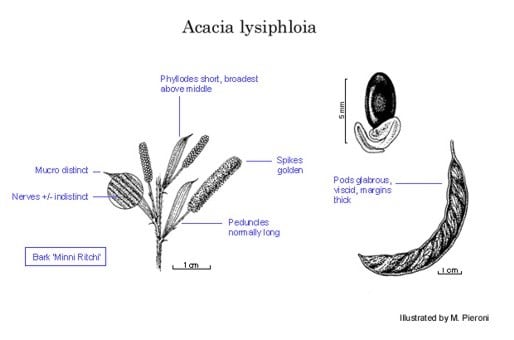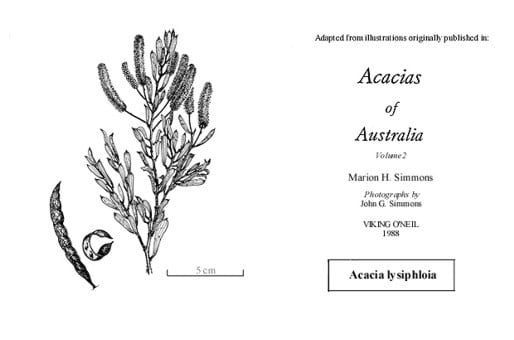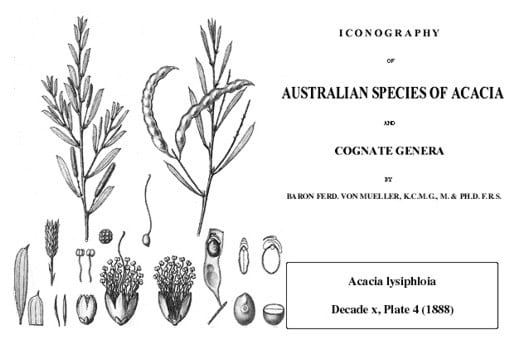Acacia lysiphloia F.Muell.
WATTLE
Acacias of Australia
Common Name
Turpentine, Turpentine Bush, Turpentine Wattle
Family
Fabaceae
Distribution
Common in arid tropical Australia, chiefly in the Kimberley region, W.A., through N.T. and into north-western Qld, between 14ºS–23ºS and 126ºE–144ºE; outliers occur in N.T. at Uluru Natl Park, and in northern Qld N of Muttaburra.
Description
Shrub to 6 m high, multi-stemmed, spreading, resinous, often viscid. Bark ‘Minni Ritchi’ type, red-brown. Branchlets angular; ridges fawn, appressed-hairy; interstices green, glabrous, lenticellate. Stipules triangular, 0.5–2 mm long, persistent. Phyllodes linear-obovate, oblique, flat, 1–5 cm long, 1.2–5 (–7) mm wide, with a short apical point, coriaceous, with conspicuous stomata, glabrous or appressed-hairy on nerves and margins, with 2–5 ±conspicuous raised longitudinal nerves (all ±confluent and inconspicuous just below apex), with anastomosing nerves obscure on broad phyllodes; gland 1, basal. Spikes 0.7–3.7 cm long, golden. Flowers 5-merous; calyx 0.3–0.8 mm long, dissected for 1/2 their length or almost to base, ±glabrous; corolla 0.9–1.6 mm long, dissected for 1/3–1/2, often papillous; ovary hairy. Pods slightly or variably more constricted between seeds or straight-sided, straight to strongly curved, flat, 2–10 cm long, 6–9 (–12) mm wide, thinly coriaceous to firmly chartaceous, obliquely reticulate, viscid; margins thick and yellowish. Seeds oblique, 4.2–5 mm long, black; areole closed, depressed, surrounded by a conspicuous pale halo.
Phenology
Flowers Apr.–Sept.
Habitat
Grows in sandy or gravelly soils, often on laterite, on plains or hillsides, frequently along streams, in open mixed eucalypt and Acacia woodland, low scrub or spinifex grassland.
Specimens
W.A.: 13 miles [20.8 km] W of Kununurra, F.Lullfitz L6194 (CANB, NSW). N.T.: 172 km from Borroloola, Daly Waters road, S.Jacobs 1677 (BRI, CANB, K, NSW, US); Uluru Natl Park, P.K.Latz 10675 (NT); 50.4 km W of Timber Creek, M.D.Tindale 10123, P.Munns & R.Turley (DNA, MO, NSW, PERTH). Qld: 36 km WSW of Normanton, S.Jacobs 1243 (BRI, CANB, K, MEL, NSW, TL, US, Z); 20 miles [32 km] E of Camooweal, B.Maloney 10/70 (AD, K, NSW, PERTH).
Notes
Details of ecology, utilisation, etc. of A. lysiphloia are given in L.A.J.Thomson & N.Hall, Austral. Acacias no. 24, CSIRO Division of Forestry & Forest Products (1989). Details of fire tolerance and Aboriginal use are given by P.Latz, Bushfires & Bushtucker 106 (1995).
The following specimens are probable A. lysiphloia × A. monticola intergrades: Sisters Plateau, c. 96 km due SE of Derby, W.A., B.R.Maslin 2671 (MEL); ‘Highland Plain’, N.T., Henry 231 (NSW). Acacia monticola is one of the species bridging sections Plurinerves and Juliflorae. Acacia lysiphloia is very closely allied to and rather doubtfully distinct from A chisholmii which may usually be distinguished by the two raised nerves of the narrower phyllodes.
FOA Reference
Data derived from Flora of Australia Volumes 11A (2001), 11B (2001) and 12 (1998), products of ABRS, ©Commonwealth of Australia
Author
Dr M.D.Tindale and Dr P.G.Kodela with the assistance of M.Bedward, S.J.Davies, C.Herscovitch, D.A.Keith and/or D.A.Morrison
Minor edits by J.Rogers
This identification key and fact sheets are available as a mobile application:
URL: https://apps.lucidcentral.org/wattle/
© Copyright 2018. All rights reserved.
